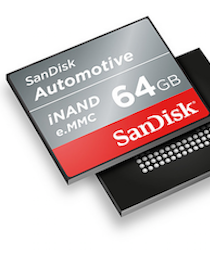Flash storage is paving the way for the connected car

SanDisk automotive
2015 was a big year for the connected car, writes Martin Booth from SanDisk Industrial and Automotive Solutions. It was the year that the fabled car of the future made a giant leap from a concept towards something we can actually touch and feel, with various car manufacturers pushing the limits with a broad range of connectivity features and functionalities. With many of these vehicles featuring advanced connected applications that were once only possible on a smartphone or, in some cases, on the pages of science fiction novels, it is safe to say that we are now in the age of the connected car.
Cars are no longer simply mediums of transportation, they are now channels for connecting with the world around us. The cars of today are more technologically sophisticated, enabling infotainment applications that use in-vehicle Wi-Fi hot spots to support high-definition video streaming for multiple devices, as well as safety and diagnostics features.
A recent Gartner report forecast that “about one in five vehicles on the road worldwide will have some form of wireless network connection by 2020, amounting to more than 250 million connected vehicles” and that the “proliferation of vehicle connectivity will have implications across the major functional areas of telematics, automated driving, infotainment and mobility services.”
As we settle into 2016, we are already seeing more models from car manufacturers with connectivity features and the new applications built around them. Smartphone-to-car integration will allow a more seamless integration between what you can do on your phone before and after you get in your car, and what can be done in the car itself.
Many commentators have also predicted the rise of other features such as advanced driver assist features (ADAS) and over-the-air (OTA) software updates for all the systems in your car. These new connectivity features will enable cars to interact with infrastructure such as traffic signs, variable speed limits (vehicle to infrastructure), and each other (vehicle to vehicle) – as well as send data to the cloud for use by cities and highway agencies to better optimize traffic flows (signal light timing for example based on real-time time of day traffic patterns).
These innovations are among the many connected trends increasing the generation and consumption of data and the need for higher endurance and higher capacity storage. Many in the automotive industry are turning to flash storage to enable many of these functions – from storing the basic OS and advanced software applications, to collecting and analysing drive time data, and buffering cloud communications to optimize the use of bandwidth, to storing local copies of infotainment data. When you consider that each of the numerous connected sensor or applications in the connected car, be it autonomous drive systems or mapping systems, could require anywhere from 4GB to 1TB of storage, the importance of storage becomes clear. In fact, some speculate that we will soon see the connected car generate as much as a 1GB of data per second that needs to be stored, processed and analysed.
As the car further evolves into a smart device on wheels, a focus the speed of connectivity and reliability of storage also is becoming more essential. End users are used to a high level of performance with their other smart devices and the connected car will be expected to deliver at the same level.
To put it in perspective, look at the leaps in innovation in mobile phones over the last ten years. They evolved from basic flip phones with simple displays that allowed voice and texting to today’s smartphone that has a large screen, processing power and storage that is as capable as any PC from a few years ago. These computers in your pocket are replacing your camera, newspaper, gaming console and a whole host of what used to be mostly deskbound functions. Flash storage has been a key enabling technology that has allowed these advancements. Flash has proved its functionality and reliability in a range of different devices and now it is transforming the automotive world. The fact is, when CPU, networking and memory bandwidth, processing speeds and capacities will continue to increase, new and more intelligent functions can be enabled. With flash storage adoption increases in the automotive industry, we’ve only seen tip of the iceberg of its potential impact to the connected car.
